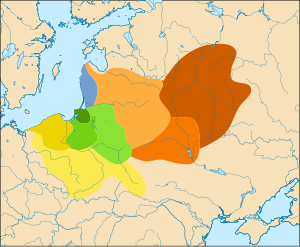
The Baltic languages are a branch of the Indo-European language family spoken natively or as a second language by a population of about 6.5–7.0 million people mainly in areas extending east and southeast of the Baltic Sea in Europe. Together with the Slavic languages, they form the Balto-Slavic branch of the Indo-European family.

The Balts or Baltic peoples are an ethno-linguistic group of peoples who speak the Baltic languages of the Balto-Slavic branch of the Indo-European languages.
Lithuanian mythology is the mythology of Lithuanian polytheism, the religion of pre-Christian Lithuanians. Like other Indo-Europeans, ancient Lithuanians maintained a polytheistic mythology and religious structure. In pre-Christian Lithuania, mythology was a part of polytheistic religion; after Christianisation mythology survived mostly in folklore, customs and festive rituals. Lithuanian mythology is very close to the mythology of other Baltic nations – Prussians, Latvians, and is considered a part of Baltic mythology.

Saulė is a solar goddess, the common Baltic solar deity in the Lithuanian and Latvian mythologies. The noun Saulė/Saule in the Lithuanian and Latvian languages is also the conventional name for the Sun and originates from the Proto-Baltic name *Sauliā > *Saulē.
The Act of Mielnik or Union of Mielnik was an attempt to unite the Kingdom of Poland with the Grand Duchy of Lithuania in 1501. It was not ratified by the Lithuanian Seimas or by the Polish Sejm. The Act of Mielnik remained just a political project. Despite the failure to unify two countries into a single state, Poland and Lithuania were under a personal union until the Union of Lublin of 1569.
The Narva culture or eastern Baltic was a European Neolithic archaeological culture in present-day Estonia, Latvia, Lithuania, Kaliningrad Oblast, and adjacent portions of Poland, Belarus and Russia. A successor of the Mesolithic Kunda culture, the Narva culture continued up to the start of the Bronze Age. The culture spanned from c. 5300 to 1750 BC. The technology was that of hunter-gatherers. The culture was named after the Narva River in Estonia.
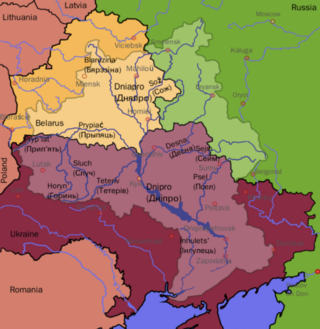
The Dnieper Balts were a subgroup of the Balts that lived in the Dnieper river basin for millennia until the Late Middle Ages, when they were partly destroyed and partly assimilated by the Slavs by the 13th century. To the north and northeast of the Dnieper Balts were the Volga Finns, and to the southeast and south were the ancient Iranians, the Scythians.

Radvila Astikas or Astikaitis was a magnate, a member of the Astikai and founder of the Radvila (Radziwiłł) family. He was a member of the Lithuanian Council of Lords and one of the most influential people in the Grand Duchy of Lithuania.

Jieznas is a small city in the Prienai district municipality, Lithuania. It is located 16 km (9.9 mi) east of Prienai along the northern shores of Lake Jieznas.
Stanislovas Kęstgaila (1503–1532) was a Lithuanian nobleman, son of Stanislovas Kęsgaila from the Kęsgaila family. Stanislovas Kęstgaila was the Elder of Samogitia (1527–1532) and castellan of Trakai (1528–1532). After marriage to Anna, daughter of Stanisław Kiszka, Stanislovas was the wealthiest magnate in the Grand Duchy of Lithuania.
The Kunda culture, originating from the Swiderian culture, comprised mesolithic hunter-gatherer communities of the Baltic forest zone extending eastwards through Latvia into northern Russia, dating to the period 8500–5000 BC according to calibrated radiocarbon dating. It is named after the Estonian town of Kunda, about 110 kilometres (70 mi) east of Tallinn along the Gulf of Finland, near where the first extensively studied settlement was discovered on Lammasmäe Hill and in the surrounding peat bog. The oldest known settlement of the Kunda culture in Estonia is Pulli. The Kunda culture was succeeded by the Narva culture, who used pottery and showed some traces of food production.
History of Lithuania or Academic History of Lithuania is a thirteen-volume series of books dedicated to the history of Lithuania. Its first volume was published in 2005, and its last volume is scheduled for publication in 2011. After its completion it will be the largest and the most comprehensive academic publication covering Lithuania's history ever released. As of 2011 five volumes had been released.
The Rzucewo was a local archaeological culture of late Neolithic. It centered at the coast of the Bay of Gdansk (Danzig) and Vistula Lagoon and extended north to the Curonian Lagoon and up to Šventoji settlement in Lithuania. It is either named after the adjacent bays or after an archeological site in the village of Rzucewo (Rutzau) near Puck.
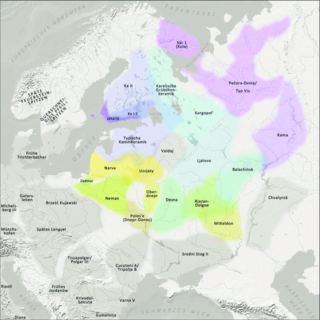
The archaeological Neman culture existed from about 5100 to the 3rd millennium BC, starting in the Mesolithic and continued into the middle Neolithic. It was located in the upper basin of the Neman River. In the north, the Neman culture bordered the Kunda culture during the Mesolithic and the Narva culture during the Neolithic.
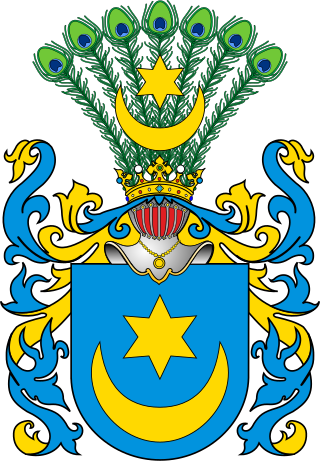
Jan Jurjewicz Zabrzeziński or Zaberezhsky was a noble of Leliwa coat of arms from the Grand Duchy of Lithuania, who achieved the height of his influence during the reign of Alexander I Jagiellon (1492–1506). He was duke's marshal (1482–1496), regent of Polatsk (1484–1496), castellan of Trakai (1492–1498), voivode of Trakai (1498–1505), and Grand Marshal of Lithuania (1498–1508). Zabrzeziński was married to Anna, daughter of Jan, elder of Brest and Hrodna.
Stanislovas Čiupurna was a Lithuanian noble, Court (1395–1407) and Grand Marshal of the Grand Duchy of Lithuania (1407–1411). As a close ally of Grand Duke Vytautas, he was one of the chief diplomats in the conflict over Samogitia with the Teutonic Knights.
The Farmers' Party was a liberal political party in inter-war Lithuania.
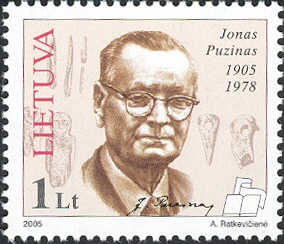
Jonas Puzinas was a Lithuanian archaeologist and specialist on the prehistory of Lithuania. He belonged to the first generation of Lithuanian scholars who matured in independent Lithuania (1918–40). He was the first scientifically trained archaeologist of Lithuania and he laid the foundations, including some of the basic terminology and periodization, for future archaeological studies. His work in Lithuania was cut short by World War II. In 1944, he retreated to Germany and then to the United States. There he continued his academic work, notably editing Lithuanian encyclopedias.
Lubys Cabinet was the 5th cabinet of Lithuania since 1990. It consisted of the Prime Minister and 17 government ministers.

Lithuania Ascending: A Pagan Empire within East-Central Europe, 1295–1345 is a Stephen Christopher Rowell's book published in 1994 by Cambridge University Press about the history of Lithuania of 1295–1345, centering on the expansion of pagan Lithuania in Eastern and Central Europe. It was republished in 1995, 1997, 2000. Osvaldas Aleksa translated the book into the Lithuanian language and it was published in 2001 by Baltos lankos.

